On winged feet
On winged feet
Authors: Bev Thurber and Niko Mulder - August 6, 2023
In a slightly modified form this article has been included in Kouwe Drukte 78, October 2023
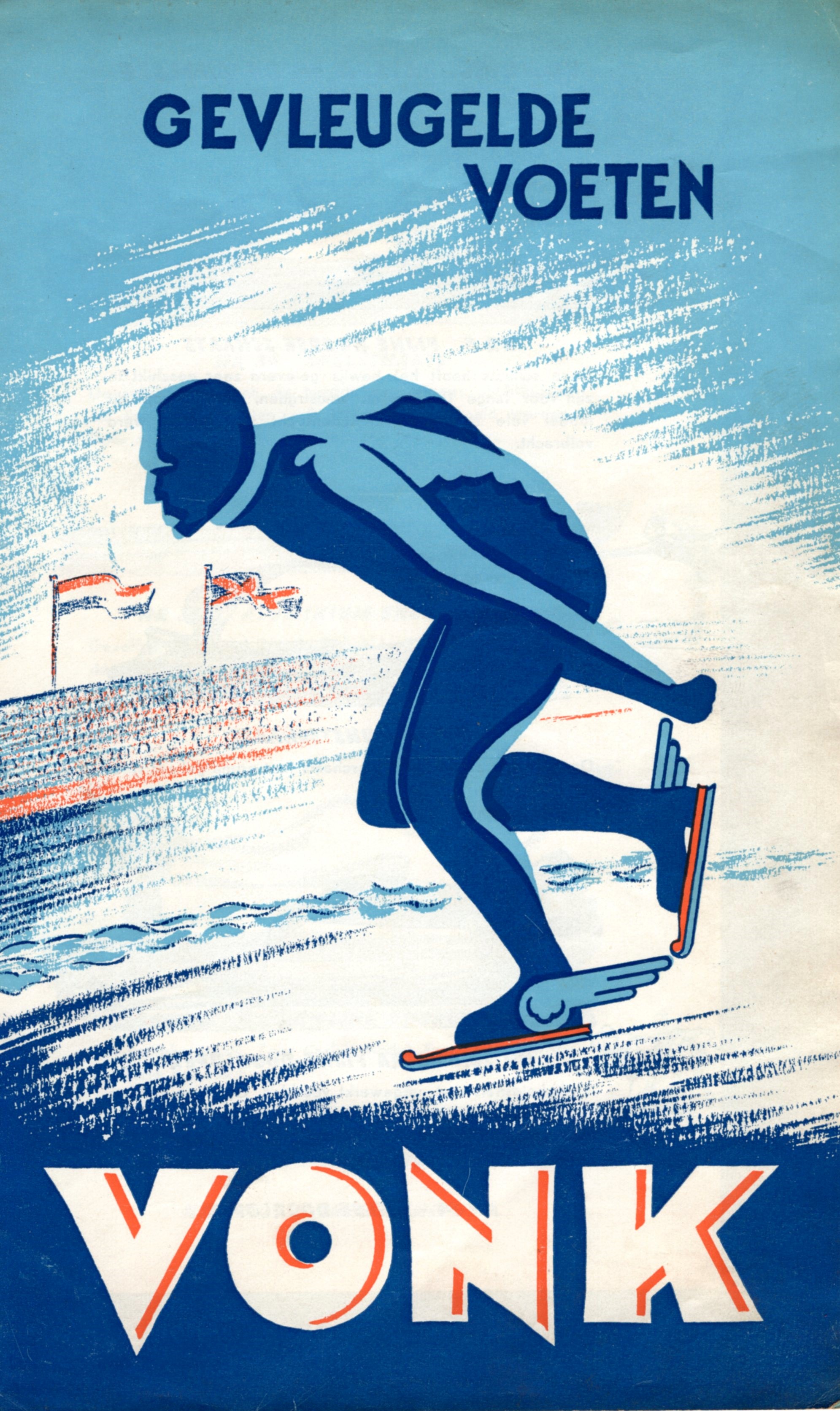
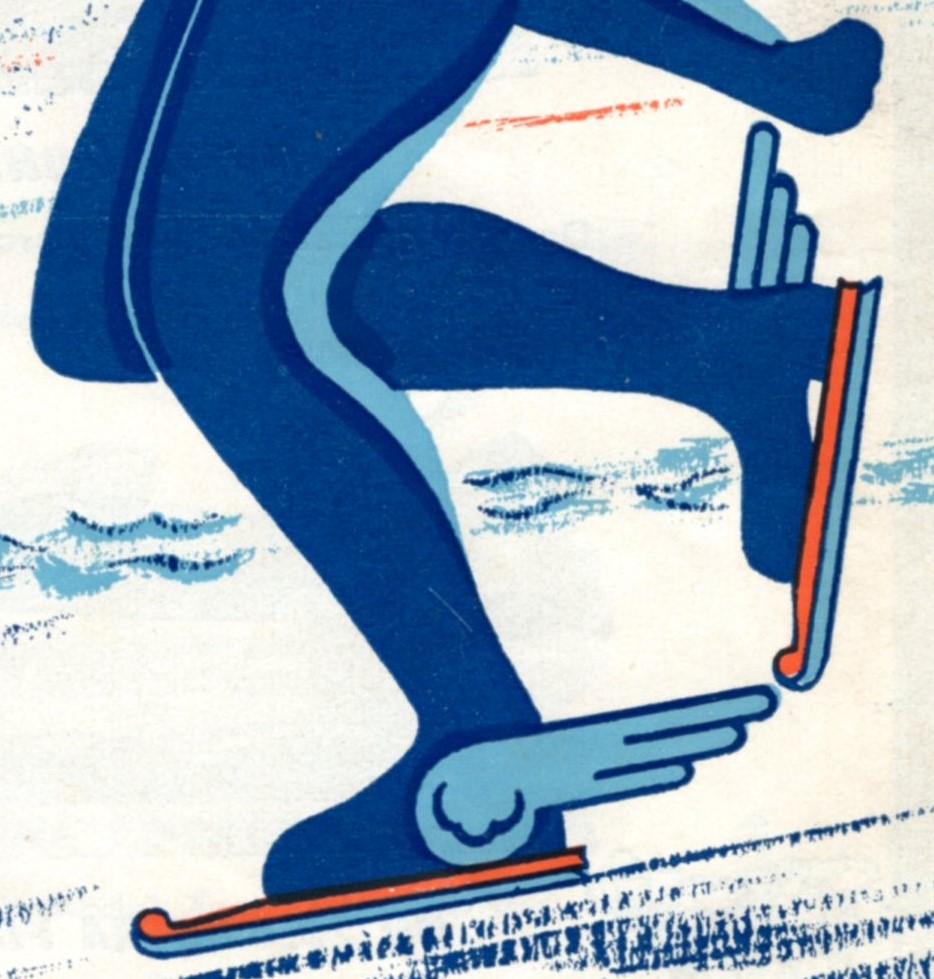 In the early 50s, skate manufacturer Egbert Vonk of Oudeschoot came out with a new leaflet, Winged feet.1 The title and design match closely. The cover shows a speed skater with wings on the outside of his boots. The design looks modern, even a bit futuristic for the time.
In the early 50s, skate manufacturer Egbert Vonk of Oudeschoot came out with a new leaflet, Winged feet.1 The title and design match closely. The cover shows a speed skater with wings on the outside of his boots. The design looks modern, even a bit futuristic for the time.
Yet the idea was not at all original. Vonk’s wings joined a long line of predecessors. In fact, the origin of the winged foot is centuries older than metal-bladed skates ...
Gallery of feathered skates
Egbert Vonk had been in the business for over 30 years and should have become aware of the symbolism of the winged skate at some point. He did not have to go far from home: izeren wjukken (iron wings) is a metaphor for skates in Frisian. The brothers Castelein used it as the title of their 1936 book about Frisian speed skaters.2
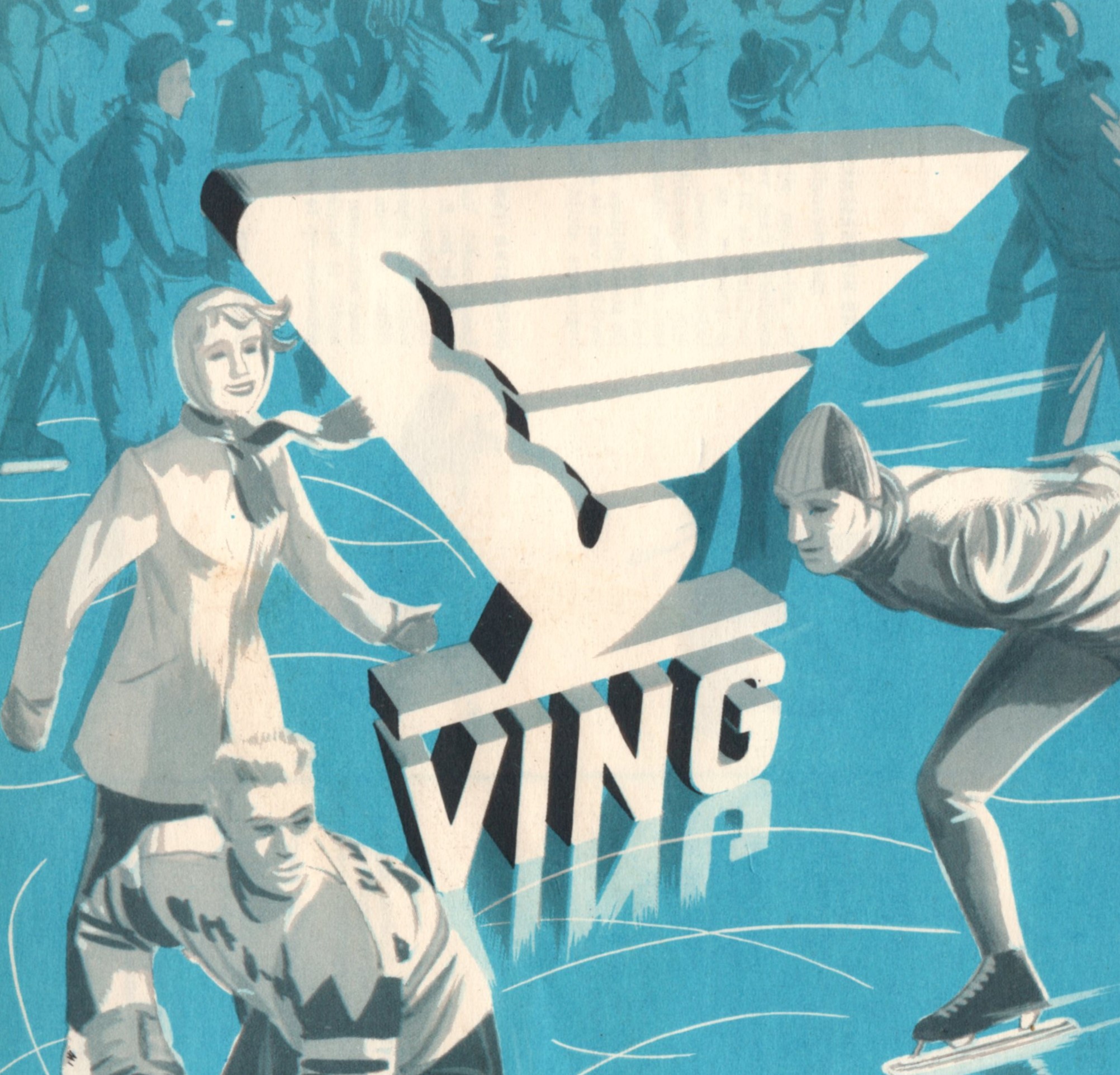
Ving, 1960s
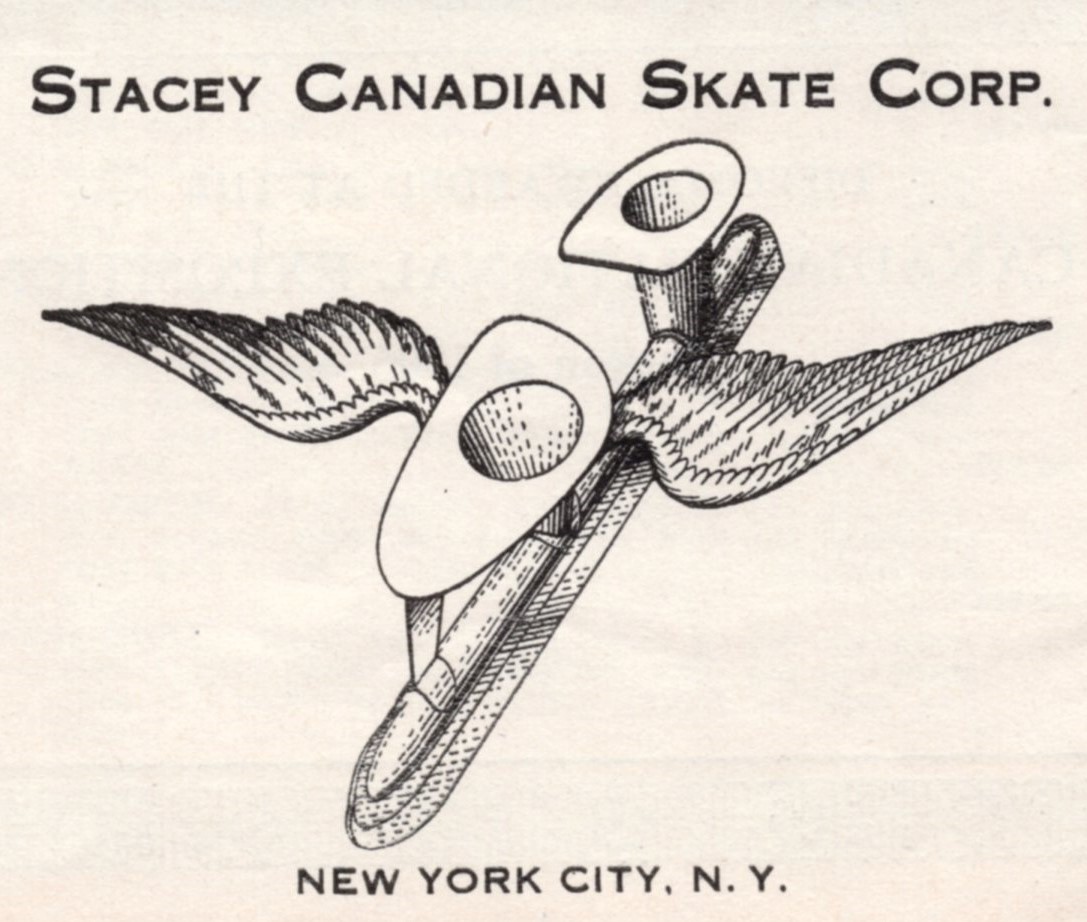
In addition, the Christiania Staal & Jernvarefabrik (Steel and Ironware Factory) in Moss used a stylized wing as its logo.3 Although that Ving was taken from the name of the owner, Wilhelm Rosenvinge, it fit in perfectly. As the maker of the Ballangrud skate, this factory was a formidable international competitor of Vonk.
Vonk probably didn’t know that on the other side of the Atlantic, there were several other ice and roller skate manufacturers using winged skates in their logos4 5 6 7 during his working life.
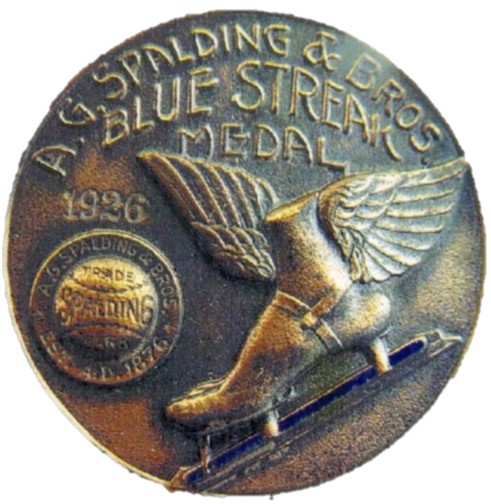
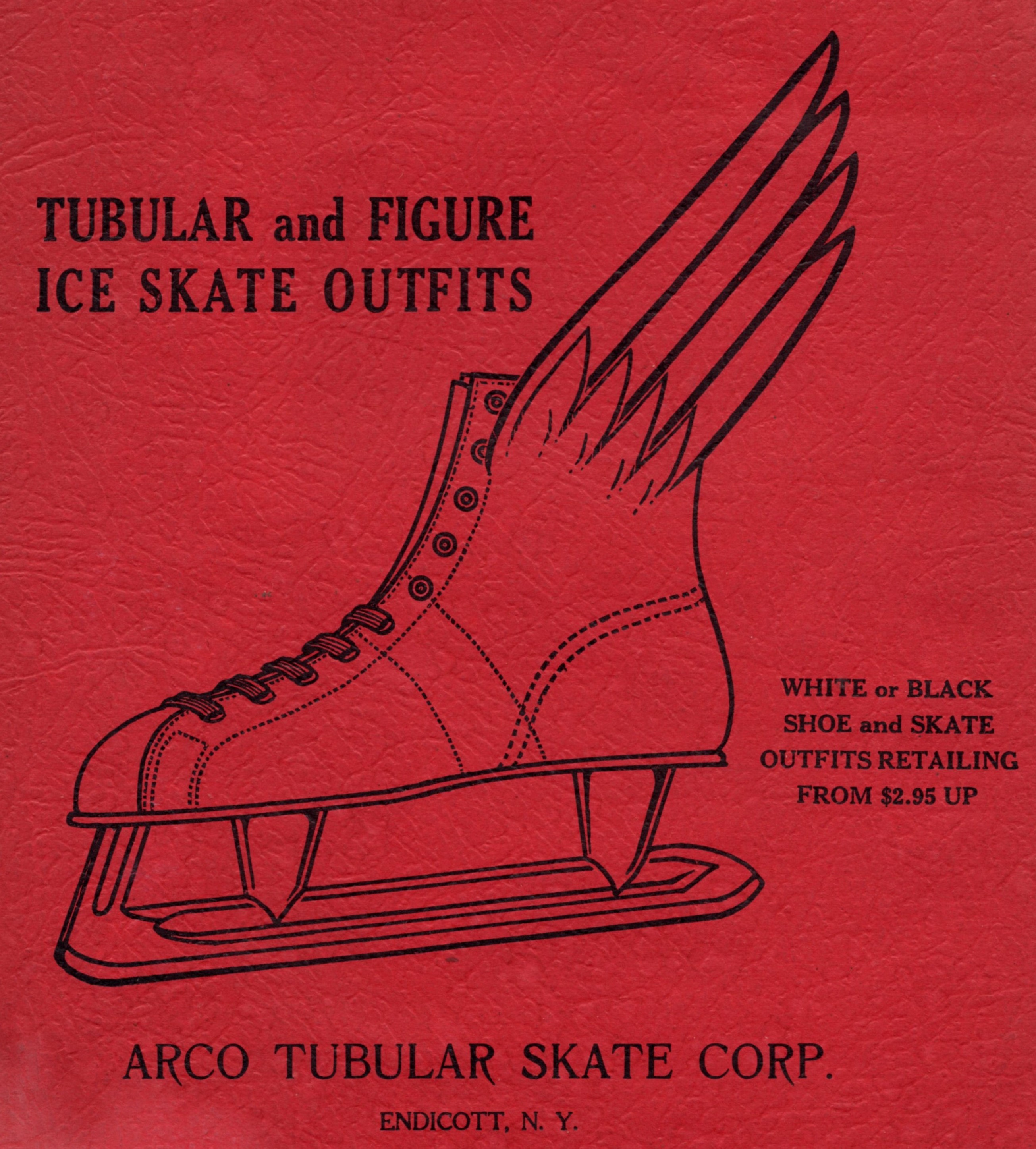
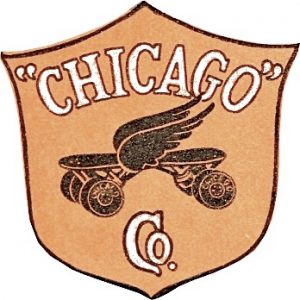
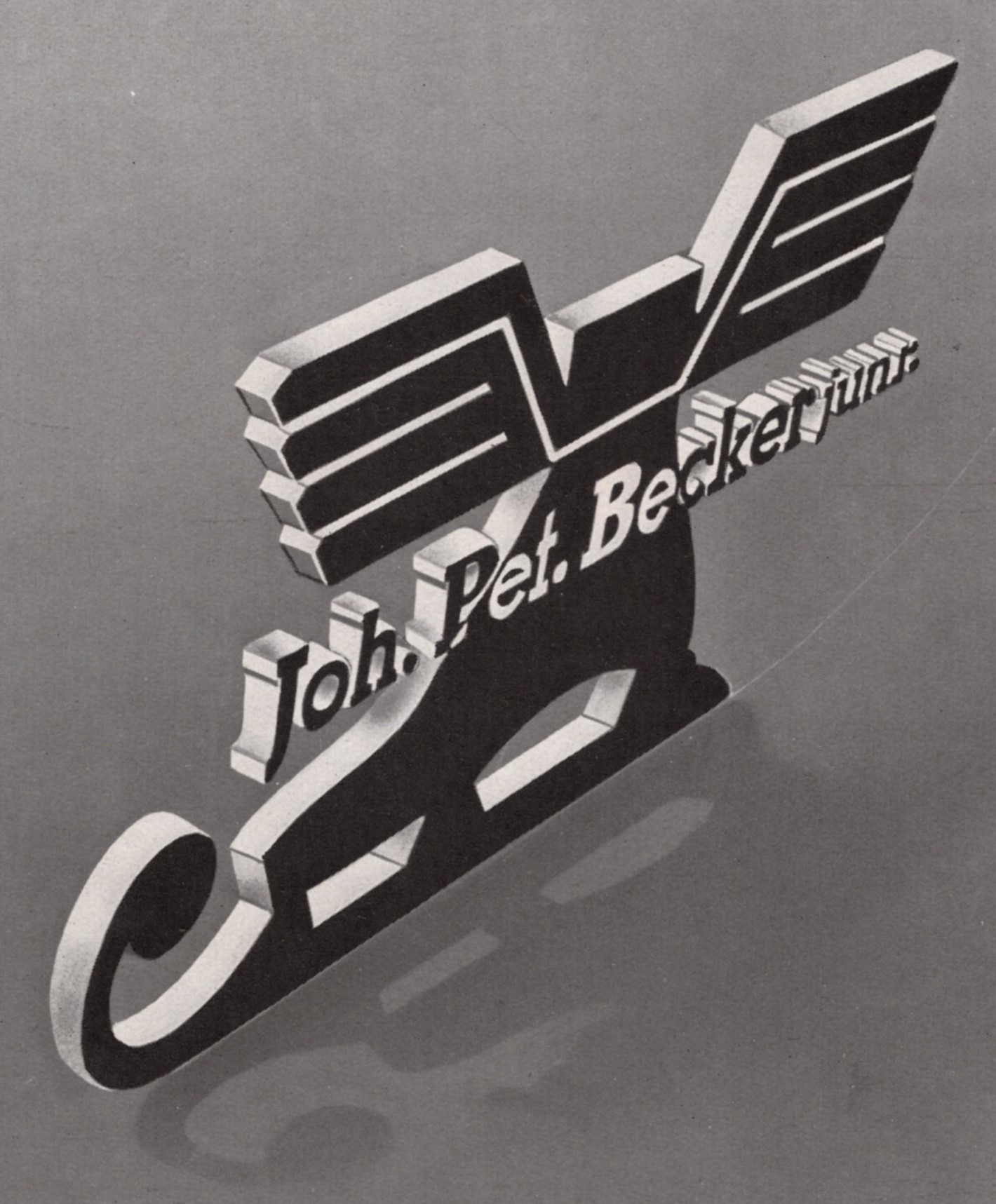
He may also have been unaware of the number of skating clubs8 with wings in their logos.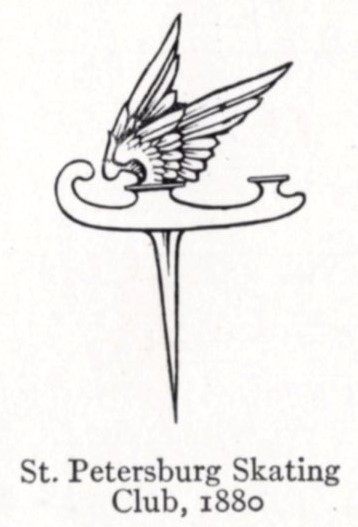
But he almost certainly knew of the trademark used by Johan Peter Becker, Jr., of Remscheid, before the second World War one of the largest skate manufacturers in the world.9
A flight of imagination
At first glance, it seems obvious to explain the winged skate by the similarity between the flap of a wing and the stroke of a skate. Swirling and soaring over the ice as fast as flight, what metaphor applies better to skating than the comparison with the free flight of a bird in the air? It is common in poetry and stories in various languages.
Multatuli expressed the feeling around 1838 in Myn schaatsen10 [My skates]:
| De stroom die des zomers gestaag heeft gevloeid | The stream that flowed steadily through the summer |
| Vergunt nu den ryder op yzer geschoeid, | Now supports a rider shod with iron, |
| Op zyn rug als een zwaluw te zweven. | Soaring on its back like a swallow. |
Underlying meaning
However self-evident it may seem, the similarity between a skater’s stroke and a wing’s flap isn’t enough to explain the symbolism of the winged foot on its own. There is a deeper meaning under its plumage. This pokes its head out in a skate model that Johan Peter Becker, Jr., presented in 1877.

With its wing screw (Flügelschraube), the skate fits in well with the concept of spreading your ‘wings’ on the ice.11 The pinch is in the name. Why was this model called Merkur? Mercury, the Roman god of commerce and messenger of the gods, couldn’t skate a single stroke!
Mercury’s tools
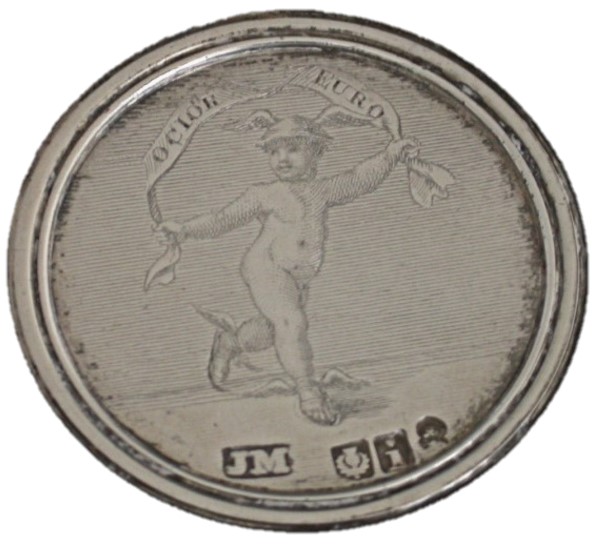
That may be the case, but he could fly and soar with the best, or so the story goes. This myth was known in Remscheid as well as Edinburgh, home of the oldest skating club in the world. The Edinburgh Skating Club traditionally awarded medals of merit to its members.12 In the 18th century, they featured a pair of crossed skates on one side. That spoke for itself.
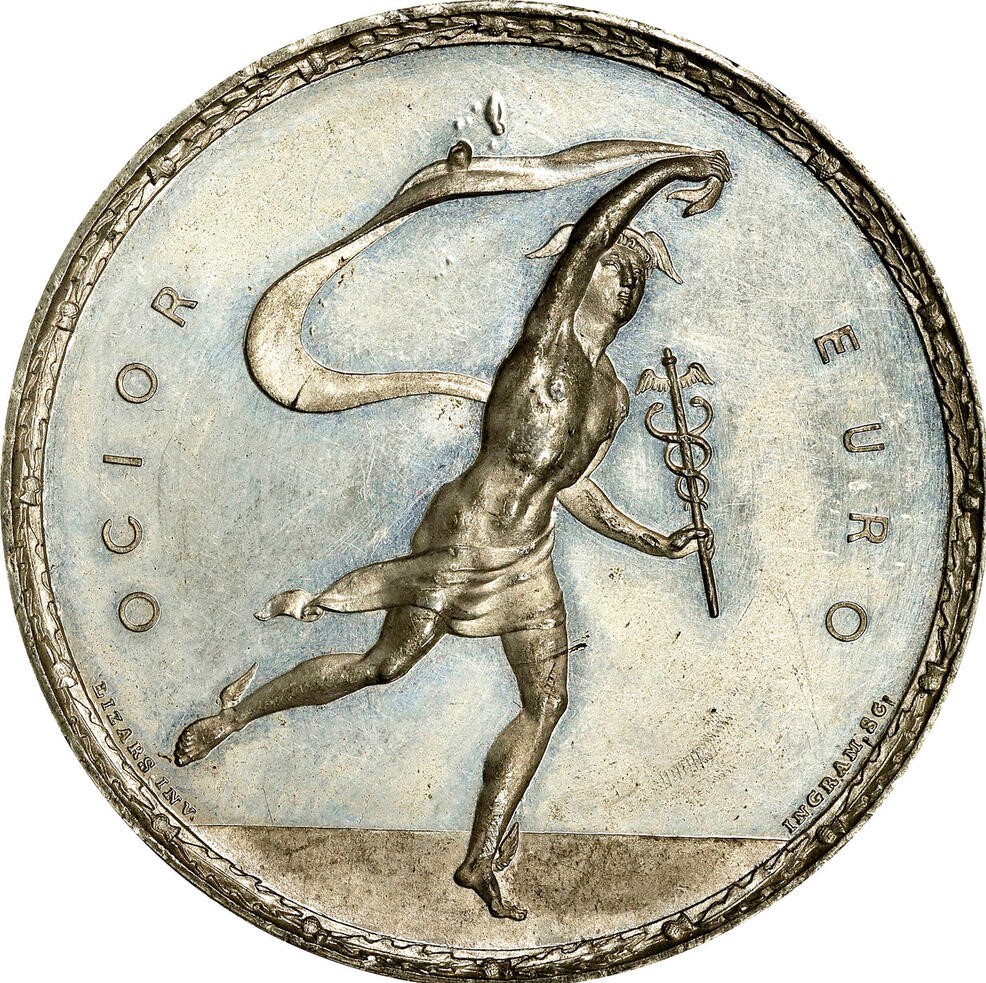 In the early 19th century, miniaturist and club member William Thomson chose a completely different design: a naked boy on skates with wings on his feet and hat.13
In the early 19th century, miniaturist and club member William Thomson chose a completely different design: a naked boy on skates with wings on his feet and hat.13
In the second half of the 19th century, portraitist John Ballantyne replaced the unclad lad on the medal with a grown man.14 He didn’t have skates, but he did have winged feet, a winged hat, and a winged staff. These are Mercury’s tools.
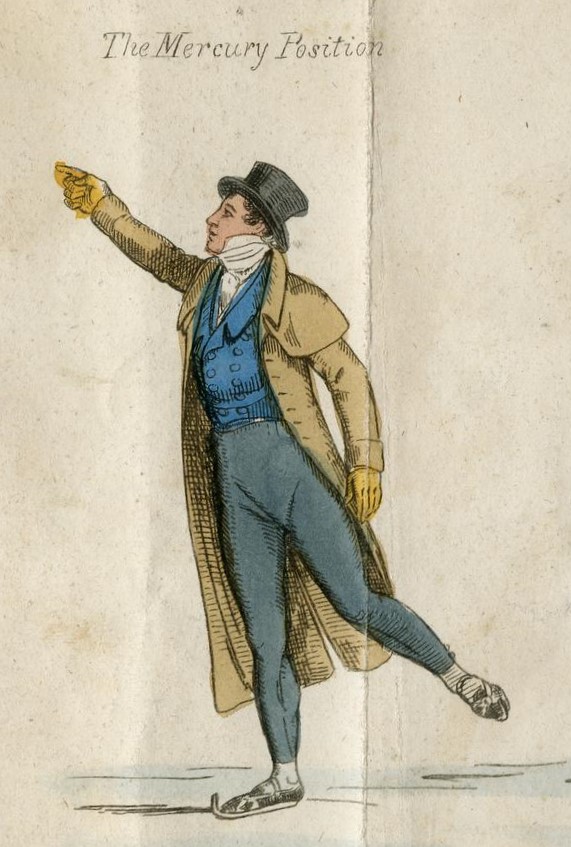
Mercury was no stranger to seasoned British figure skaters. In his book A Treatise on Skating, which was reprinted many times, Robert Jones included the flying Mercury as a skating stance to strive for.15
But this move was a poor substitute for what Jones wanted to do. He began his Treatise by lamenting his inability to trace skating back to classical literature. Although the Greeks and Romans never skated, if he had looked a little harder, he would have been able to do just that…
Flying north
Mercury was a popular character in classical mythology. Stories about him, including the Aeneid, traveled across Europe during the Middle Ages, and most of them had to be translated from Latin into local languages.
Mercury’s special equipment posed a problem for some of his fans. He wore a petasum (winged hat) and talaria (winged shoes), but what was the right way to translate them?
Several different interpretations were possible. In the 8th century, someone thought Mercury had a feðrhoman (Old English for a feather-cloak).16 A couple of centuries later, an anonymous scribe offered the Old Saxon word scridscos for talaria.17
Confusingly, Notker Labeo mixed up Mercury’s hat (petasum) and winged shoes (talaria) in the 11th century. His explanation (petasum means Mercury’s winged shoe) became the standard German interpretation.18

(The Greeks especially called Mercury’s winged shoe petasum)
Notker Labeo’s commentary on Martianus Capella’s Marriage of Philology and Mercury, 11th century.
St. Gallen Stiftsbibliothek Cod. Sang. 872, page 16, lines 17-18; courtesy of e-codices

Summarium Heinrici, Universitätsbibliothek Graz 859, folio 10rb, line 23
Between around 1100 and 1500, fifteen medieval manuscripts gave variations on schritschuh as translations for petasum in the sense of winged shoe.19 One of those was sirtescoyhe.
We have not found any examples of words meaning ‘winged shoe’ in Middle Dutch, although Jacob van Maerlant came close with ‘… enen man an die voeten ghevloghelt’20 [a man with wings at his feet].
Striding and sliding in the Middle Ages
The schrit- in schritschuh is from the Germanic verb screiþa-21, which meant both “to stride” and “to glide”. Its Old High German descendant, scrītan, was used for the smooth motion of a spear flying in Hildebrandslied (c. 830).22
Its Scandinavian cognate, Old Norse skríða, is used to describe the motion of skiers in various sagas and sliding on ice, either in shoes or on bone skates, in the mythological poem Hávamál.23 The scrithifini (sliding or skiing Finns) are mentioned in texts going all the way back to Procopius and Jordanes in the sixth century.24
We do not know if the verb scriden, later schriden and schrijden, ever had the secondary glide-meaning in Dutch. The German verb scrītan lost its glide-meaning sometime in the Middle High German period (c. 1050–1350)25, but it could have remained in schritschuh, which might have meant glide-shoe originally.26
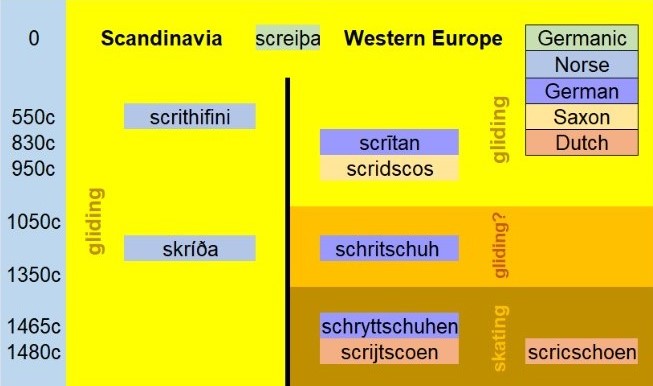
In Scandinavia, skríða always meant 'to glide', although the word skrittskoer (skridskor; literally: glide-shoes) was not recorded until 1650.
Winged shoes older than skates
Glide-shoes sound like ice skates, and schritschuh is similar to the word for an ice skate in many modern languages: Schlittschuh in German, skridsko in Swedish, and schrikschoen in Dutch. But since the earliest known metal-bladed skates are from the first half of the thirteenth century27, schritschuh could not have referred to them.
Bone skates
Bone skates were readily available back when schritschuh was coined, but it is impossible to say whether the word referred to them. The only clear medieval reference to bone skates is in Old Norse, where they are called ísleggir (literally: ice-legs).28 This word remains in use for bone skates today.29
Variations on schritschuh for skates
The oldest uses of schritschuh for skates that we’ve been able to find are schryttschuhen and scrijtscoen.
Anna Ebin’s German translation of Venite in 1465 says that Lidwina’s friends were on schryttschuhen when she fell.30

(Then they went playing on the ice in schryttschuhen)
Anna Ebin, Neurenberg, Germanisches Nationalmuseum, hs 2261, folio 123r, lines 21-23 (1457-1465)

(On scrijtscoen Damian skated on the ice)
Philadelphia, University of Pennsylvania, Ms. 739 - olim Dutch 1
Scrijtscoen, a direct variant of the German word schritschuh, occurs in a Middle Dutch poem that dates to around 1485 and served as a tool to help monks memorize the local saints’ days. It says 'Op scrijtscoen daem reet opt ijs'31 [On scrijtscoen Damian rode (skated) on the ice]. St. Damian belonged to the diocese of Utrecht, which covered practically the whole northern part of the Netherlands in those days.
In Middle Dutch, schrikschoen was more common than schrijtscoen. It appeared in a few late 15th century sources:
In 1481, 'princersse Marye van Bourgoengien ... liep menich waruen spelen vp thijs met scauerdijnen ende met scricschoen, …'32 (Princess Mary of Burgundy ... often went playing on the ice with scauerdijnen [skates]33 and with scricschoen, …).
Although this text was not printed until 1531, it was based on manuscripts from the late 15th century.
Around 1490, one of the laws for the city of Gouda read:
'noch desgelijcx te rien mit genen scoverlingen noch scrijcscoenen upter straten'34 (likewise riding (skating) on the streets, whether with scoverlingen [skates] or with scrijcscoenen, is forbidden)
It is not known when and why schrijden became schricken in the Low Countries. Was schrikschoen a corruption of scrijtscoen? Or is it derived from the verb schricken (walk with big steps)?35 In that case, was it perhaps associated with a new skating technique, and referring to the longer strokes skaters would make?
The use of the verb rijden (to ride, including the forms reet and rien in the passages with schrikschoen above) is typical of the Low Countries. The expression 'rijdende op dat ijs' did not even require the name of the object that was used for it.36 But we suspect it was schrickschoen because this combination is also found in the 15th century Low German translation of Venite from Dalheim:
'under de voeten schrickschoen ofte schouerlick, dar men op dat ijs mede pleget to rijden in dem lande' (schrickschoen or schouerlick under the feet, with which people are used to ride on the ice in that country).37
This sentence is nearly identical to Middle Dutch and the use of rijden (to ride) seems to indicate an unknown Dutch source.
Anna Ebin and these other authors were not the first to write schritschuh or its variants down, but they may have been the first to use the word for Mercury's footwear for metal-bladed skates.
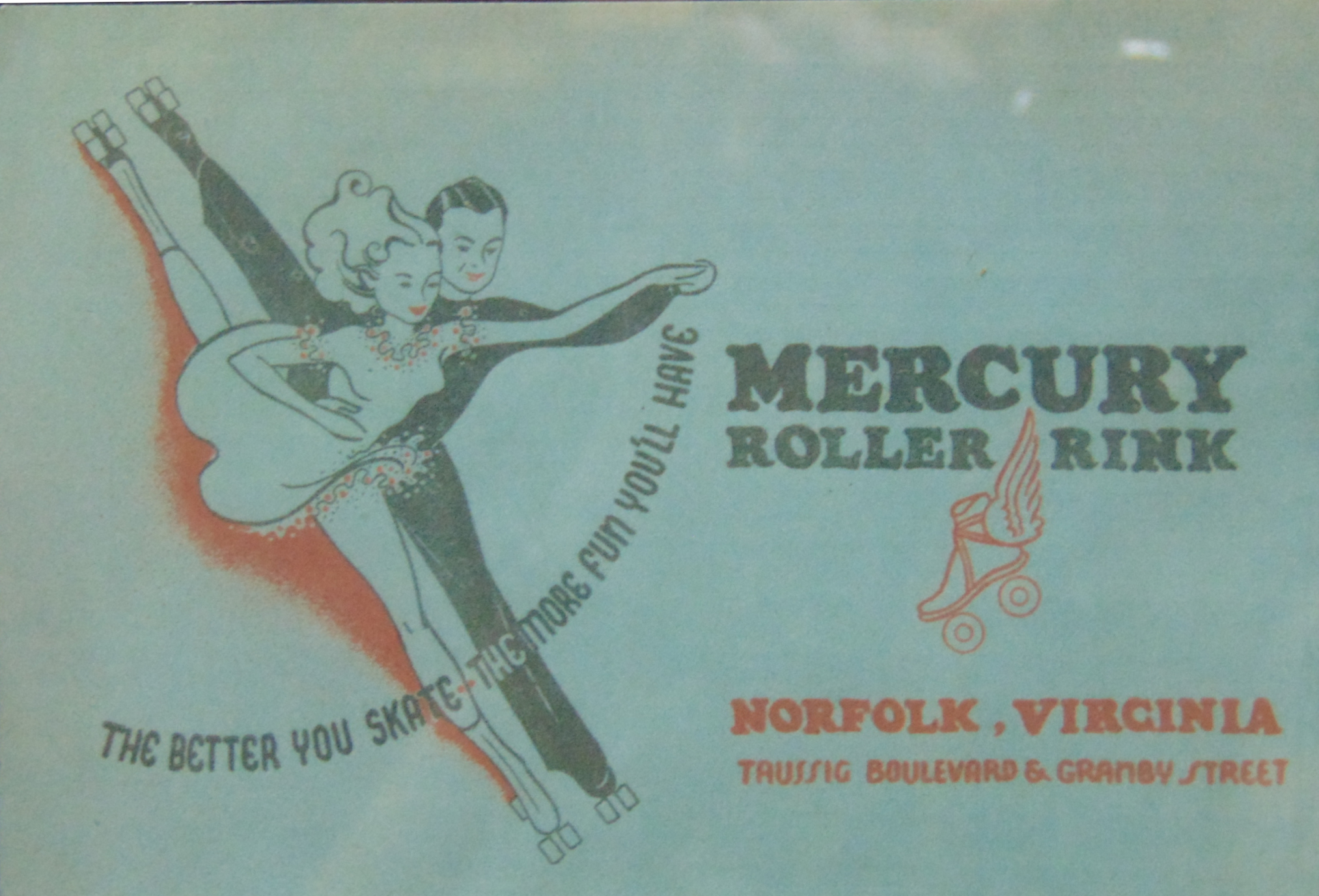
For unknown reasons?
Unless Mercury is mentioned, as in the name of an American roller rink, or clearly intended, as in the design of Vonk’s leaflet, it is almost impossible to know why individual clubs, skaters, and skate-makers chose to include wings.
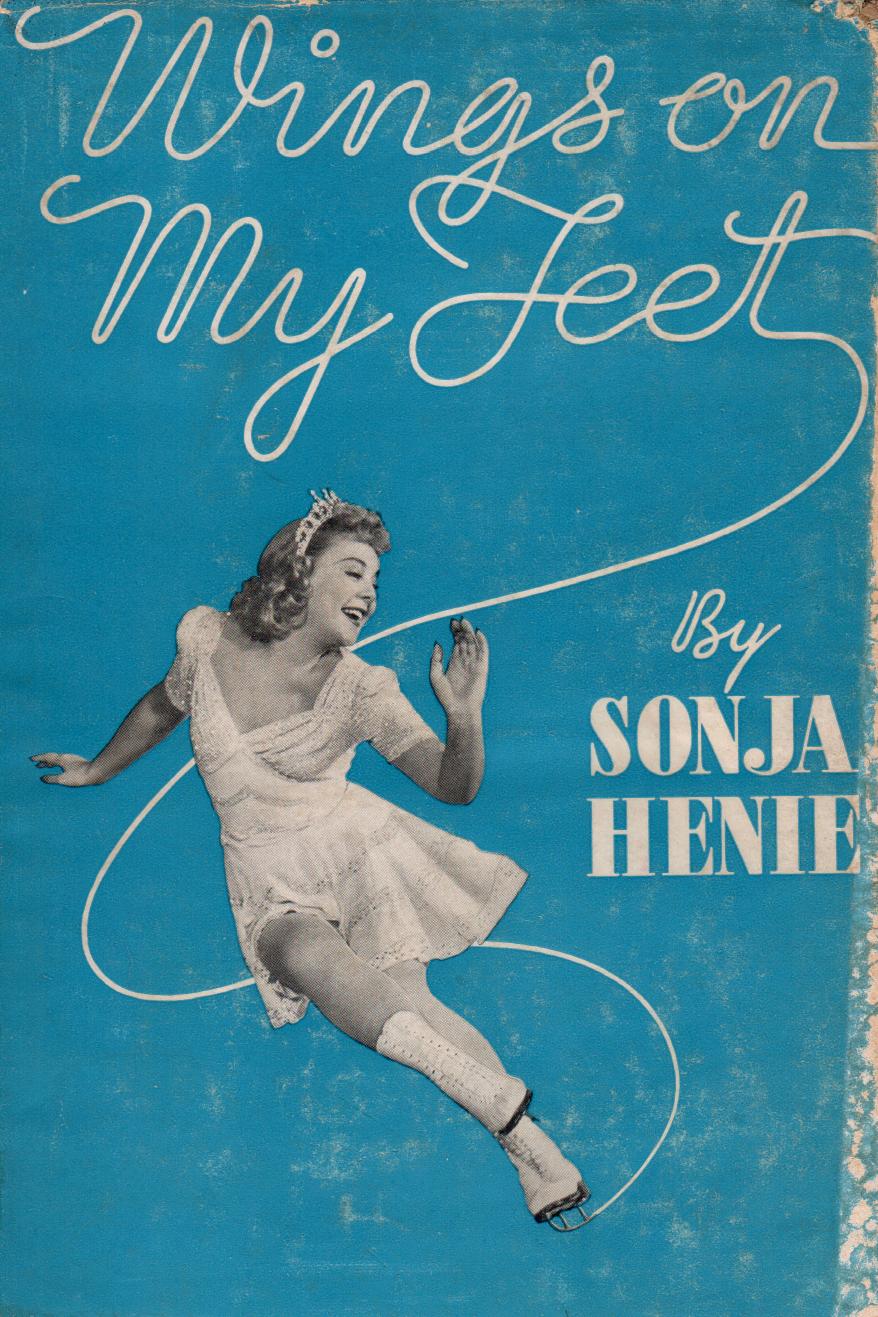
They might have meant to evoke the sensation of flying while skating, as could hold true for Norwegian figure skater Sonja Henie, who called her autobiography Wings on My Feet (1940).
Although the words in the title match the winged feet in Vonk’s leaflet, Henie’s title refers to the ‘quality of literally flying through space … It is this complete release from feeling earthbound that makes skating the fun it is.’38
Multatuli was aware of both options. He compared skaters soaring on the ice to swallows, then mentioned Mercury (see Extras).
Wings might also have been used for purely aesthetic reasons, as could have been the case with an anonymous Scandinavian skate maker who provided the foot plates of his skates with wings.39
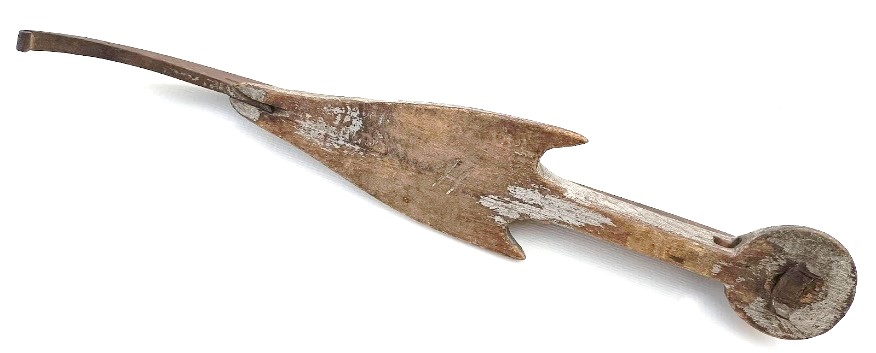
from a 19th-century farm outside Grampian, Pennsylvania, U.S.A.
The mark H (for höger or høyre, meaning right) and the typical heel screw
clearly show a Scandinavian provenance.
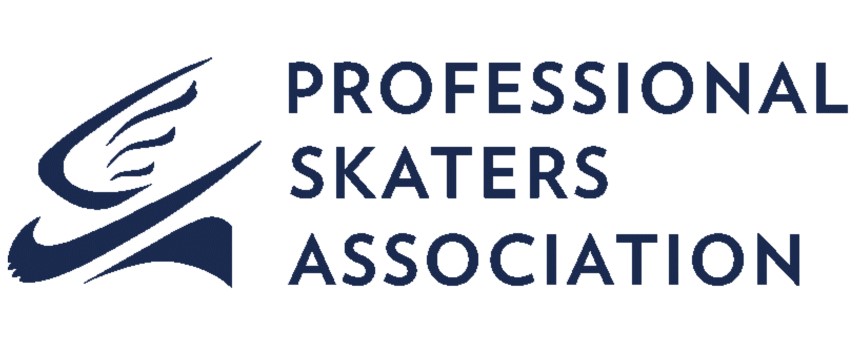
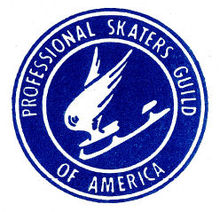 The concept of skates as wings for feet survives in the logo of the Professional Skaters Association in the USA, although their website does not explain why they chose it.
The concept of skates as wings for feet survives in the logo of the Professional Skaters Association in the USA, although their website does not explain why they chose it.
The abstract design looks much more modern than the logo of the PSA's predecessor, the Professional Skaters Guild Of America, from 1956.
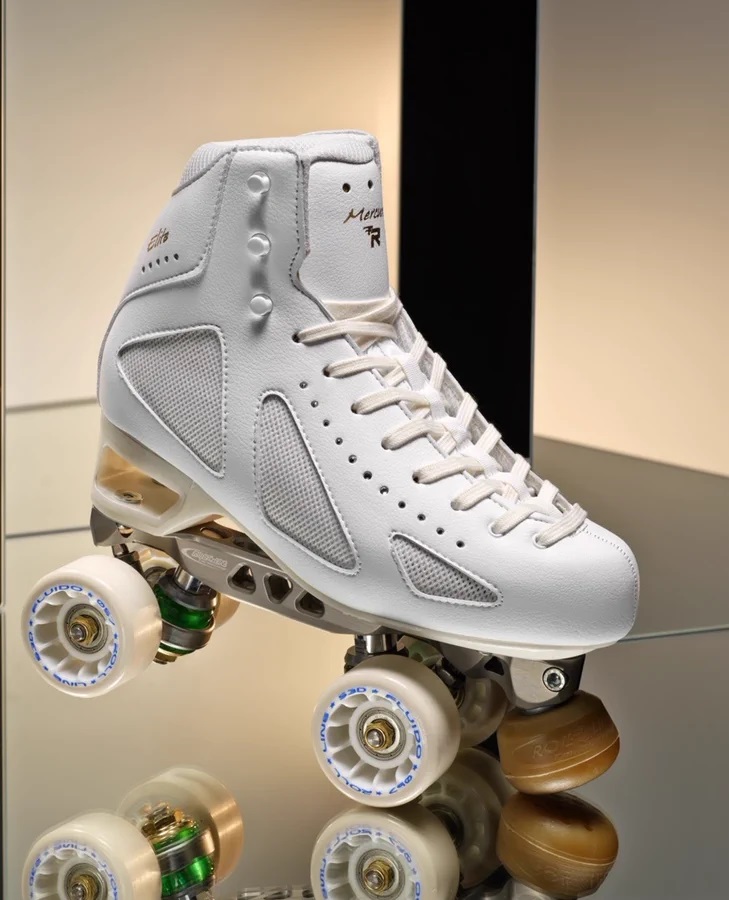
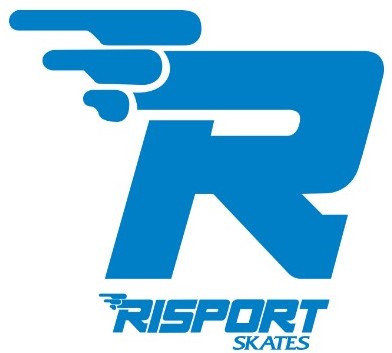 The Italian skate-maker Risport, sporting a winged R as a trademark, has not forgotten who skaters got their wings from: its top roller skating boot is called Mercurio.
The Italian skate-maker Risport, sporting a winged R as a trademark, has not forgotten who skaters got their wings from: its top roller skating boot is called Mercurio.
This company is not unique in that. Astoundingly, Mercury’s name is connected with several other companies and models, for both inline and ice skating!40
By far the best known among them was John Wilson of Sheffield, England, who introduced a Mercurio figure skate in the 1950s.

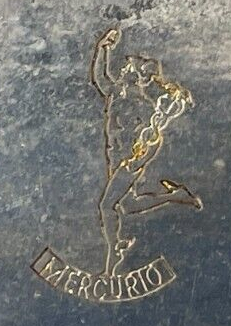
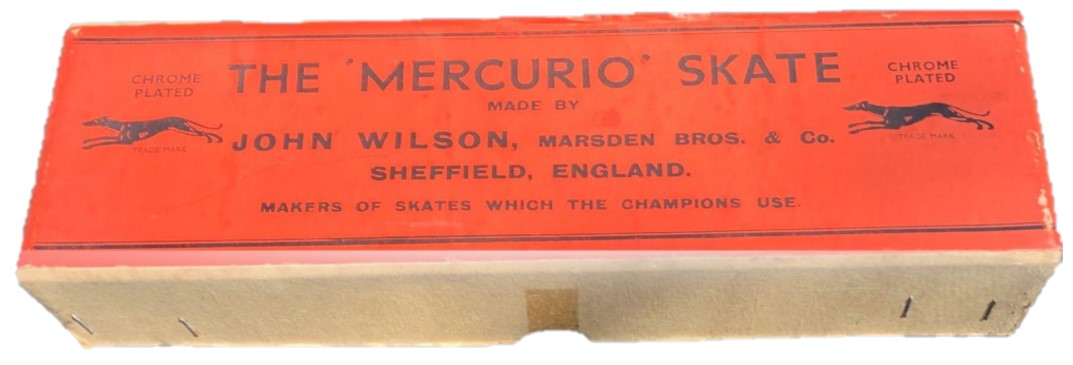
References
1. Leaflet Gevleugelde schaatsen, Schaatsenfabriek Vonk, Oudeschoot, Friesland, Netherlands, circa 1955. Private collection.
2. J. en M. Castelein - Op iiz'ren wjukken, Brandenburgh & Company, Sneek, 1936.
3. Leaflet Ving, Christiania Staal & Jernvarefabrik, Moss, Norway, circa 1960. Private collection. The Ving-logo was used from about 1930 to circa 1980.
4. Leaflet, Stacey Canadian Skate Corp., New York, 1918. Private collection.
5. Blue Streak Medal 1926, A.G. Spalding & Bros, New York / Chicago. In Ed Braakman - Schaatsenmakers en patenthouders Verenigde Staten van Amerika, private publication, 2005.
6. Tubular and Figure Ice Skate Outfits, catalog of Arco Tubular Skate Company, Endicott, New York, 1939-1940. Private collection.
7. Logo, “Chicago” Roller Skate Co., circa 1930s-1940s. Website Made in Chicago Museum.
8. Logo, St. Petersburg Skating Club, 1880. In Irving Brokaw – The Art of Skating, Charles Scribner's Sons, New York, 1926, p. 10; Anonymous - 'Spotlight on Club Emblems' in Skating, official magazine of United States Figure Skating Association 27: 2, December 1949.
9. Catalog, Joh. Peter Becker junr., 1937. Private collection.
10. Multatuli – Myn schaatsen, circa 1838. In Brieven. Deel 1. Eerste periode tot 1846, ed. Mimi Douwes Dekker, W. Versluys, Amsterdam, 1891. DBNL.org.; R. Voskuyl - 'Myn schaatsen', Kouwe Drukte 71, April 2021, p. 12-14.
11. Merkur skate, 1877-1930. Private collection.
12. The Edinburgh Skating-Club with Diagrams of Figures and a List of the Members. William Grant, Edinburgh, 1865, p. 17–18.
13. Medal, Edinburgh Skating Club 1814. Website Steppes Hill Farm Antiques Ltd.
14. Medal, Edinburgh Skating Club 1864-1901. Website Coin Archives.
15. The Mercury Position. R. Jones - The Art of Skating, 1823. Website The British Museum, inventory number 1931,1114.626.
16. M. Fox - ‘Feðerhama and hæleðhelm: The Equipment of Devils’, Florilegium 26: 131-57, 2009, p. 136.
17. Oxford, Bodleian Library, MS Auct F.1.16, page 126b, line 6. See ‘scritiscuoh’ in Rudolf Schützeichel - Althochdeutscher und Altsächsischer Glossenwortschatz, Niemeyer, Tübingen, 2004.
18. Notker’s commentary on Martianus Capella’s Marriage of Philology and Mercury. In Paul Piper - Die Schriften Notkers und seiner Schule, vol. 1, pt. 2, Akademische Verlagsbuchhandlung von J.C.B. Mohr, Freiburg / Tübingen, 1882, p. 701.
19. ‘Scritiscuoh’ in Rudolf Schützeichel - Althochdeutscher und Altsächsischer Glossenwortschatz, Niemeyer, Tübingen, 2004. MS dates from handschriftencensus.de.
20. Jacob van Maerlant - Der naturen bloeme (1266), ed. Eelco Verwijs, J.B. Wolters, Groningen 1878, book 12, line 1205-1206. DBNL.org.
21. ‘Schlittschuh’ in Friedrich Kluge - Etymologisches Wörterbuch der deutschen Sprache, ed. Elmer Seebold, 24th ed., de Gruyter, Berlin, 2002.
22. R. Meissner - 'Zum Hildebrandslied', Zeitschrift für deutsches Altertum und deutsche Literatur N.F. 30(=42): 122-128, 1898.
23. B. A. Thurber - Skates Made of Bone: A History, McFarland, Jefferson, NC, U.S.A., 2020, p. 93-99. Line 2 of verse 83 of Hávamál, a poem in the Poetic Edda, is ‘en á ísi skríða’ (slide when on ice); it is not clear whether the sliding was done in shoes or on bone skates, but it certainly does not refer to metal-bladed skates because they were not available in Scandinavia when it was written.
24. J. Weinstock - Skis and Skiing from the Stone Age to the Birth of the Sport, Edwin Mellen, Lewistown, NY, U.S.A., 2003, p. 8-9.
25. 'Schreiten' in Deutsches Wörterbuch von Jacob Grimm und Wilhelm Grimm, Trier Center for Digital Humanities, dwb.uni-trier.de.
26. Fossilization of old meanings of words in set phrases is a well-known phenomenon. For example, in English, the expression 'to proof yeast' means to test yeast to make sure it still works. The older meaning of ‘proof’, to test, survives in this phrase but few others. Another example is ‘the exception that proves the rule’: here the exception is actually testing the rule, not supporting it. Likewise in Dutch the old meaning of 'schricken' (taking big steps) only survives in 'schrikkeljaar' (leap year).
27. O. Goubitz - 'Nederland's oudste schaats?', Kouwe Drukte 9, September 2000, p. 4-5; W. Blauw - Van Glis tot Klapschaats, Van Wijnen, Franeker, 2001, p. 57.
28. B. A. Thurber - Skates Made of Bone: A History, McFarland, Jefferson, NC, U.S.A., 2020, p. 87-88; ‘islägg’ in Svenska Akademiens ordbok, SAOB.se.
29. B. A. Thurber - Skates Made of Bone: A History, McFarland, Jefferson, NC, U.S.A., 2020, p. 129. However, its use is declining in favor of 'skridskor på djurben' (skates of animal bone) among regular people.
30. Anna Ebin - Venite, Neurenberg, Germanisches Nationalmuseum, hs 2261, folio 123r, lines 21-23 (1457-1465); Niko Mulder - 'Lidwina - op schaatsen of schalootsen?' , Kouwe Drukte 77, April 2023, p. 7,#8.
31. Philadelphia, University of Pennsylvania, Ms. Codex 739 (olim Dutch 1); Youri Desplenter - 'Vrouwe, laet Jan de mamme suyken / Barthelmees is een kolkuyken. Een Middelnederlandse cisiojaan in een bijzonder Hollands psalter (ca. 1485)', Queeste, Tijdschrift over middeleeuwse letterkunde in de Nederlanden 15: 36-54. DBNL.org.
32. Anonymous - Dits die Excellente Chronijcke van Vlaenderen, Willem Vosterman, Antwerp, 1531. DBNL.org
33. Scauerdijnen, scoverlingen, and schouerlick were variants of another Dutch word that Cornelius Kiliaan said meant skates in 1599: ‘Calopodia ferrata, quibus nostrates mira celeritate atque dexteritate labuntur per adstrictas glacie aquas’ (iron-shod shoes on which our natives glide with surprising speed and dexterity across frozen water). Etymologicum teutonicae linguae, ed. F. Claes s.j., Mouton, The Hague, 1972, entry ‘schauerdijnen’. DBNL.org.
34. J. Verdam - 'Uit Goudsche rechtsbronnen', Tijdschrift voor Nederlandse Taal- en Letterkunde 38: 239-255, 1919. DBNL.org
35. Middelnederlands Woordenboek (MNW), digital version, Instituut voor de Nederlandse taal, https://gtb.ivdnt.org/.
36. Anonymous - TLeven, Ghent UB 1080, fol. 217v-218r (ca. 1480); Niko Mulder - 'Lidwina - op schaatsen of schalootsen?', Kouwe Drukte 77, April 2023, p. 7, #7.
37. Anonymous - Venite, Berlin, Staatsbibliothek codex mgq 1240, fol. 5v-6r (15th century); Niko Mulder - 'Lidwina - op schaatsen of schalootsen?', Kouwe Drukte 77, April 2023, p. 7, #9.
38. Sonja Henie - Wings on My Feet, 1940, p. 101. Scan of cover, collection Bev Thurber.
39. Winged skate from private collection. The data on the provenance of the skate were supplied by Jan Biegelaar.
40. Examples include an inline skate designed by Pouyan Mokhartarani, a hockey skate and the inline frames produced by US manufacturers Verbero and Endless Blading, respectively, and an inline skate produced by Australian manufacturer Blade X.
Extras
Skating like the Homeric gods
The modern German word for an ice skate, Schlittschuh, is a reanalysis (adaptation) of schritschuh. By the eighteenth century, schreiten no longer meant ‘to glide’, and skating had become popular. People began saying Schlittschuh instead of Schrittschuh because skating seemed more like sliding (schlittern) than striding (schreiten).
When Goethe and Klopstock met in 1775, they
... sprachen nämlich auf gut oberdeutsch von Schlittschuhen, welches er [Klopstock] durchaus nicht wollte gelten lassen: denn das Wort komme keinesweges von Schlitten, als wenn man auf kleinen Kufen dahinführe, sondern von Schreiten, indem man, den Homerischen Göttern gleich, auf diesen geflügelten Sohlen über das zum Boden gewordene Meer hinschritte.1
(spoke namely in good Upper German about Schlittschuhen (ice skates), which he [Klopstock] absolutely refused to accept: the word in no way comes from Schlitten (sled), as if one went along on little runners, but rather from Schreiten (stride), in that one, like the Homeric gods, strides across the sea become ground on these winged soles.)
Klopstock was absolutely right to correct Goethe, but not for the reason he gave.
Mercury in Multatuli’s Myn schaatsen
After his lines quoted above, Multatuli continues with the flying theme, bringing in Mercury:
| 't Vertelsel by de ouden dat vroeger Mercuur | The story by the ancients that Mercury in the past |
| Met gevleugelden hiel had gevlogen | Had flown with a winged heel |
| Het make in een dichtstuk dan beter figuur, | Though it might make a better figure in a poem |
| 't Kwam welligt te pas by zyn Godennatuur, | And may have suited his divine nature |
| Ik zeg u, 't is schandlyk gelogen. | I tell you it's a blatant lie. |
| En als ik geleefd had by Griek en Romein | And if I had lived by Greek and Roman |
| Het zouden geen vleugels maar schaatsen dan zyn. | It wouldn't be wings, but skates. |
| Doch wat gaat Mercuur met zijn vleugels ons aan, | But what do we care about Mercury and his wings, |
| Ook ons zijn die vleugels gegeven. | Those wings have also been given to us. |
| Wanneer wy op grachten of stroomen den baan | When on canals and streams we |
| Al garend en zwevend ten-einde weer gaan, | Go floating to the end of the track, |
| Dan heeft men genot van het leven.2 |
Then one enjoys the pleasure of life. |
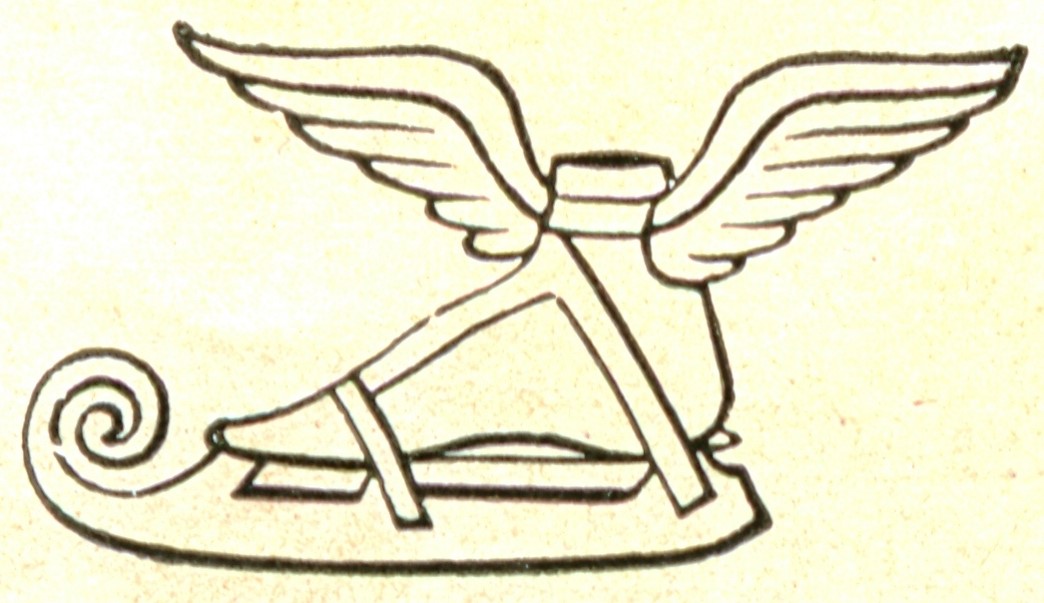
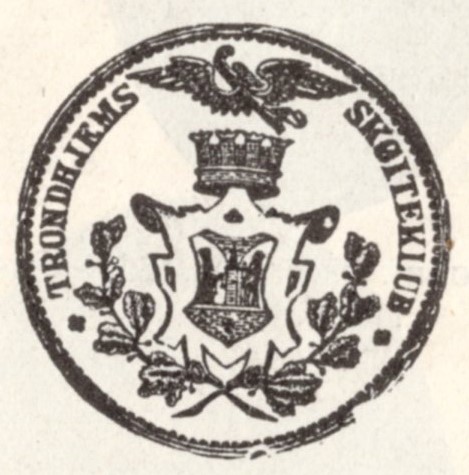
Winged skate above the crown on top of the coat of arms.
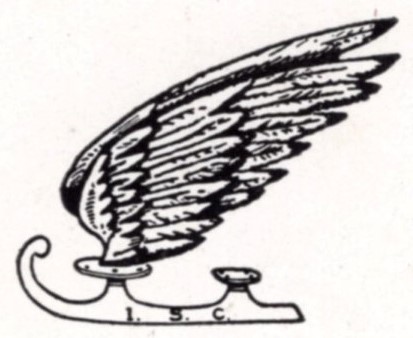
Irving Brokaw - The Art of Skating, 1926, title page
Brokaw was the founder of ISC
The US roller skating sticker craze
From the 1920s to 1950s, it was common for roller rinks in the United States to distribute promotional stickers. Skaters collected these, often putting them on their skate cases. Today, the National Museum of Roller Skating in Lincoln, Nebraska, U.S.A. maintains a very large collection of these stickers. The exact number is unknown because not all have been cataloged, but it must be in the thousands.
Many of the stickers feature wings of some sort. Max McKillip, the museum’s archivist and docent, estimated that between a third and half the stickers have wings. Why was this motif so popular?
This appeal to classical mythology seems to have been part of a larger trend noted by Anthony Barnstone.3 Using mythological characters in advertising logos was common during this time, with Mercury among the most popular.
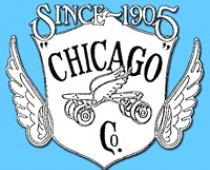 As part of this trend, the Chicago
As part of this trend, the Chicago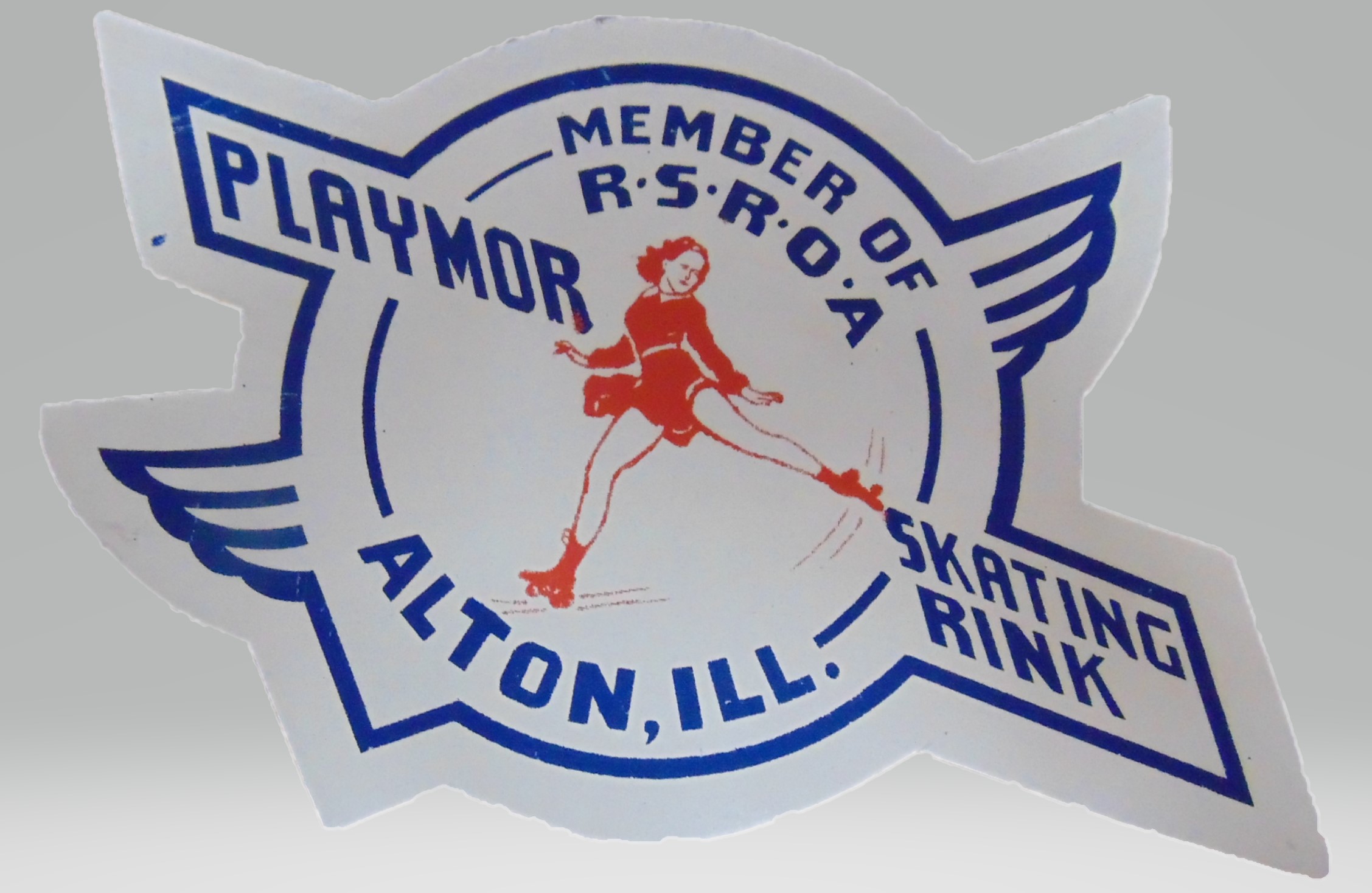 Roller Skate Company, founded in 1905, selected a winged roller skate for its logo. It advertised extensively and also produced templates for rink operators to base their own promotional materials on, including a winged skate to be used as a club emblem.4
Roller Skate Company, founded in 1905, selected a winged roller skate for its logo. It advertised extensively and also produced templates for rink operators to base their own promotional materials on, including a winged skate to be used as a club emblem.4
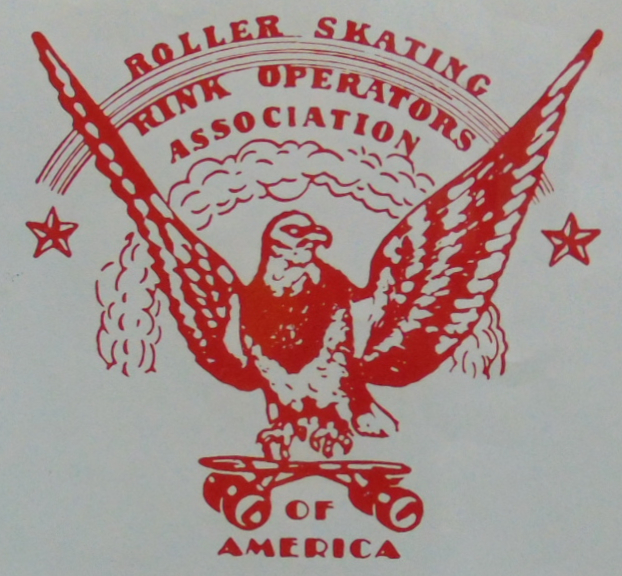
This may have influenced the Roller Skating Rink Operators Association when it was founded in 1937.
Its logo, an eagle with wings spread over a roller skate, combines the American eagle with winged skate imagery.
The winged skate image remained popular in subsequent decades. Barnstone describes Mercury as 'a design cliche' that required only 'the shorthand symbol of his small wings' to invoke him.
The roller skating industry reached this point fairly rapidly, with the result that some rinks simply included small wings in their sticker designs.
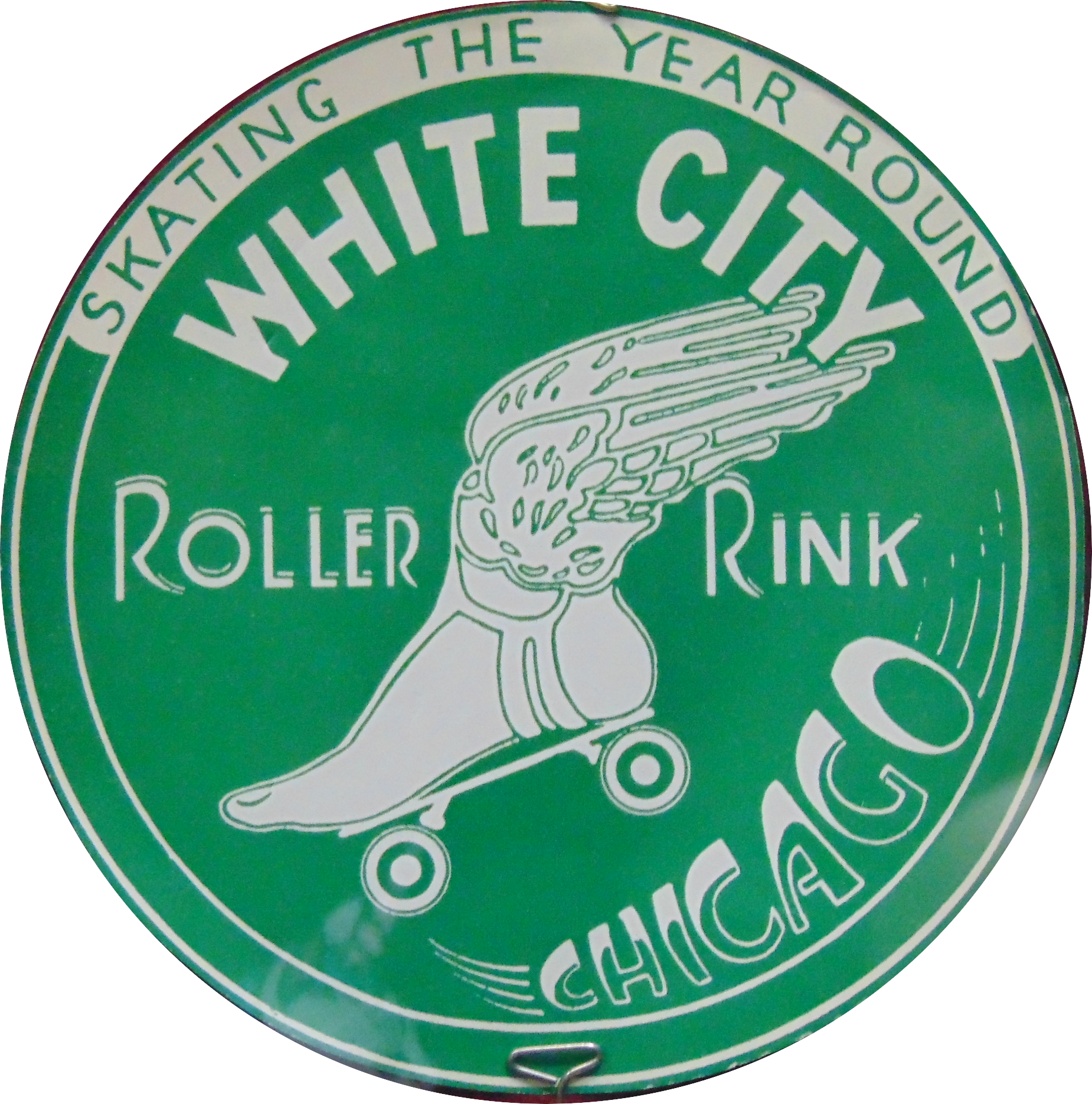
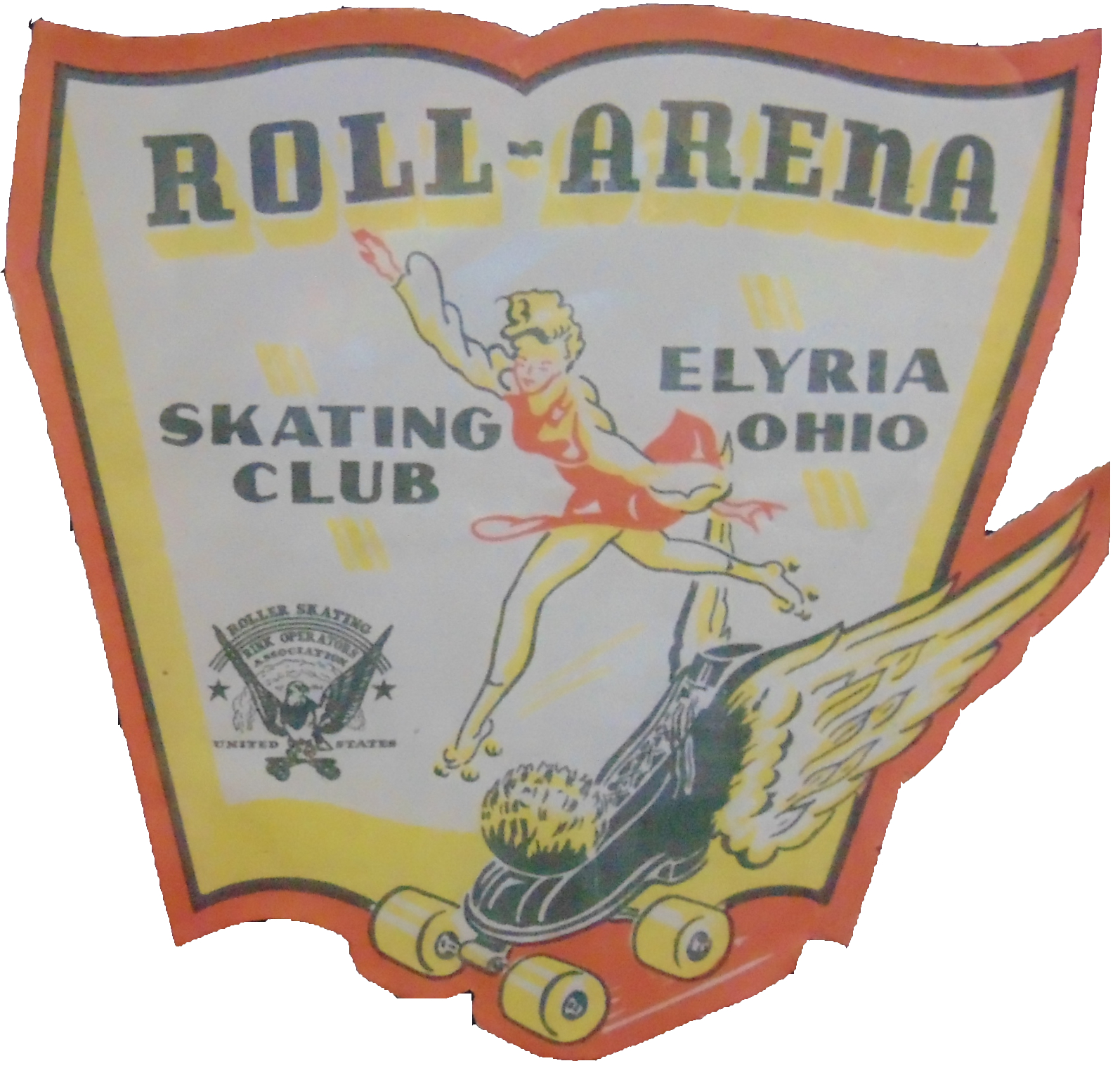

Other uses of schritschuh
In one of his sermons5, German mystic Meister Eckhart (c. 1260-c. 1328) mentions two schritschuwe for the soul to use as it unites with God:
Nu schrit edile sele / zuch ane dîne schritschuwe / daz ist forstentnisse und minne / da mide schrit uber di werc dinir crefte / ubir dîne forstentnisse / ubir di dri ierarchien / di dri himmele und uber daz licht daz dich creftigit und sprinc in daz herze godis / daz ist in sîne forborgînkeit / da salt du inne forborgin werdin allen creaturen.
Now fly, noble soul, put on your gliding shoes, i.e., intellect and love. With them fly over the work of your powers and over your own intellect and over the three hierarchies, the three heavens and over the light that empowers you, and spring into God’s heart, that is into his hidden nature: there you will be hidden from all creatures.
This idea, including the word schritschûn, is reiterated in Der Saelden Hort (the Treasury of Blessings), an Alemannic poem from around 1300.6
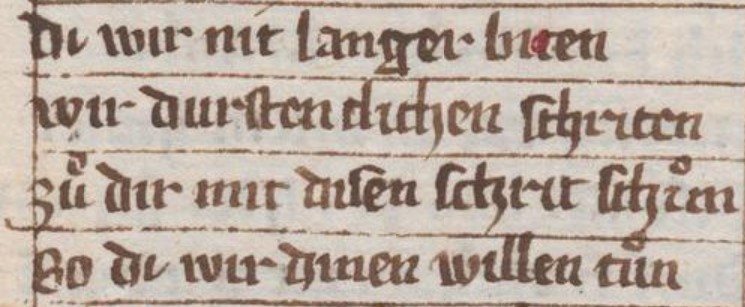
Österreichische Nationalbibliothek, codex 2841
http://data.onb.ac.at/rec/AC13960952

|
daz wir nicht langer biten, wir durstenclichen schriten zů dir mit disen schrit schůn so daz wir dinen willen tůn. |
that we not wait any longer, we boldly fly to you with these gliding shoes so that we do your will. |
These quotes are clearly not related to skating, but the idea of metaphorical wings for the soul finds a practical form in the trademark of Becker & Henckell, a skate manufacturer from Remscheid, Germany, in 1879.


References to Extras
1. J.W. von Goethe - Aus meinem Leben: Dichtung und Wahrheit, vol. 3, bk. 15, J.G.Cotta, Tübingen, 1814, p. 509. Deutschestextarchiv.de.
2. Multatuli – Myn schaatsen, circa 1838. In Brieven. Deel 1. Eerste periode tot 1846, ed. Mimi Douwes Dekker, W. Versluys, Amsterdam, 1891. DBNL.org.
3. Anthony Demetrios Barnstone - The Poetics of the Machine Age: William Carlos Williams and Technological Modernism. Ph.D. dissertation, University of California at Berkeley, 1998, p. 242-243.
4. Booklet Our Story: Roller Skating Association International, April 2012, p. 11-12.
5. Sermon 15 in Paradisus anime intelligentis (no. S 90). Oxford, Bodleian Library, MS. Laud Misc. 479, folio 30r, lines 7-13 (1325-1350).
6. H. Adrian - Der Saelden Hort: alemannisches Gedicht vom Leben Jesu, Johannes des Täufers und der Magdalena, Weidmann, Berlin, 1927, p. 78, lines 4369-4372.
Special thanks
The authors like to express their special thanks to the National Museum of Roller Skating for generously providing their images of roller skating stickers.